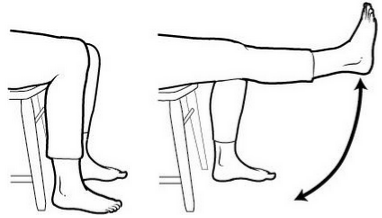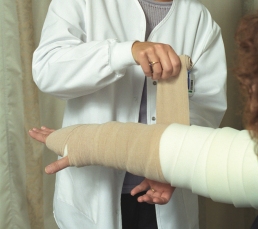 In 2015, an estimated 231, 840 new cases of invasive breast cancer are expected to be diagnosed in women in the U.S., along with 60, 290 new cases of non-invasive (in situ) breast cancer. In patients with breast cancer, recovery time varies greatly, and not every patients with breast cancer will require post-treatment rehabilitation, swelling (lymphedema) and limited range of motion following treatment can prevent them from returning to their normal daily functional activities.
In 2015, an estimated 231, 840 new cases of invasive breast cancer are expected to be diagnosed in women in the U.S., along with 60, 290 new cases of non-invasive (in situ) breast cancer. In patients with breast cancer, recovery time varies greatly, and not every patients with breast cancer will require post-treatment rehabilitation, swelling (lymphedema) and limited range of motion following treatment can prevent them from returning to their normal daily functional activities.
Treatment for breast cancer includes surgery, radiation and chemotherapy. These treatments cause many patient’s to experience fatigue, pain, stiffness, swelling or numbness in their body. This pain and numbness can be caused by nerve irritation, and nerve swelling.
Rehabilitation needs can be assessed and treated by a physical therapists, who will work closely with your doctor to set an individualized treatment plan and goals.

So How Can Physical Therapy Help?
An effective way to treat the many uncomfortable side effects of breast cancer treatment is to begin a regimen of specialized exercises. Physical therapists can set an individualized routine to strengthen the fatigued muscles and help to reduce stiffness and pain.
It is very important to increase flexibility as this can be lost during breast cancer treatment. Flexibility can improve a patient’s posture, which in turn will help with pain management.
If you have just through breast cancer treatment, you can begin visiting a physical therapist after your incision has healed.
How Can Physical Therapy Treat My Lymphedema?
For Lymphedema treatment, there are four elements of focus: compression, skin care, lymphatic drainage and massage and exercise.
Compression garments are especially helpful in minimizing swelling and reducing pain. For some patients, they will have to continue to wearing these compression garment for the long term to keep the swelling under control.
Many different styles and compression classes are available, and a therapist can help you determine which will be best for your level of swelling and the best times to wear them.
Lymphedema may show up days, months or even 20 years later! A person should realize that these precautions are for life!
REMEMBER: Swelling is easier to prevent than to get rid of!
Until we understand Lymphedema better, some PRECAUTIONS should be observed
There is the risk of developing Lymphedema after axillary node dissection with or without radiation. Some precautions should be observed to prevent or minimize Lymphedema
Avoid the following:
- All kinds of skin punctures
- Scratches, burns, and cuts
- Pet claws
- Prickly plants roses. Use gardening gloves
- Prolonged sun exposure (radiation recall) Always use sunscreen
- Jacuzzis and saunas
- Cutting your cuticles
- Injections, blood pressure, and blood draws on the affected arm.
- Tight clothing/jewelry at the wrist
- Insect bites-mosquitoes, bees
- Sleeping on that side
Helpful Hints
It might be advisable to wear a compression sleeve for the following:
- Airplane travel or long car trip
- Repetitive motion activities: housekeeping, sports, health club workouts, gardening, snow shoveling and other repetitive activities
- Activities requiring lifting more than 5-7 pounds (avoid lifting excessive weights)
Significant Suggestions
- Wear oven gloves to remove hot dishes and pans
- Meticulous skin care: Moisturize your arm daily
- Vitamin E is helpful to heal and soften scars
- Castor oil after radiation helps promote skin healing
- Keep a first aid kit with you at all times: alcohol wipes, Antibacterial cream (Polysporin/Bacitracin), Band-Aids
- When traveling, carry antibiotics with you in case of cellulitis (saves time in emergency)
- Use an electric razor to minimize chance or cuts and nicks
- Wear a medical alert bracelet
- For those with lumpectomies and/or breast swelling, sports bras can be very helpful during the day or at night
- Use two handed technique for limb protection
- Antihistamines may be helpful in preventing the first episode of Lymphedema after a cut or overuse
SIGNS OF CELLULITIS
If your arm becomes red, painful, warm, and/or swollen, this is an emergency. Contact your physician immediately! If your physician is not available, go to an emergency room
REHABILITATION CONSIDERATIONS
Exercise is always good, but don’t overdo it! Remember to always listen to your body and especially your arm!
Rehabilitation includes:
- Individual exercise programs
- Deep breath (assists lymph flow) and relaxation exercises (mediation encouraged)
- Osteoporosis prevention education and exercises
- Posture education, correction and exercises
- Manual therapy to reduce pain, scar tissue, adhesions, fibrosis and restore range of motion, strength and function
- Lymphedema prevention education or treatment
- Manual Lymphatic drainage
- Compression garment education
 Annual mammograms can detect cancer early — when it is most treatable. In fact, mammograms show changes in the breast up to two years before a patient or physician can feel them. Mammograms can also prevent the need for extensive treatment for advanced cancers and improve chances of breast conservation.
Annual mammograms can detect cancer early — when it is most treatable. In fact, mammograms show changes in the breast up to two years before a patient or physician can feel them. Mammograms can also prevent the need for extensive treatment for advanced cancers and improve chances of breast conservation.
Sources: http://www.breastcancer.org/symptoms/understand_bc/statistics


Physical therapy referrals are not as common for breast cancer patients but all patients should be aware that they have the option to see a physical therapist. An article by Wingate found that patients receiving postmastectomy physical therapy had better shoulder ROM and achieved better functional outcomes than patients who did not receive PT. In the first one to three weeks physical therapy can work on exercises including cane stretches, ER/horizontal abduction, wall walking, and pulleys. Increased attention to the strength of the serratus anterior muscle is given, whose nerve supply is vulnerable to injury during
surgery. During weeks three through six most patients are on chemo or radiation therapy and aerobic training is indicated to decrease symptoms associated with cancer treatments.
As stated in the blog physical therapy can do a lot for breast cancer patients and the word needs to be spread for the positive benefits of physical therapy.
McAnaw, M., & Harris, K. (2002). The Role of Physical Therapy in the Rehabilitation of Patients with Mastectomy and Breast Reconstruction. Breast Disease, 16, 163-174.
LikeLike
There is so much physical therapy can do to help women who are recovering from breast cancer! This article provides good information on how physical therapy can aid in the recovery of lymphedema, but more importantly how it can address pain and decreased function during recovery which isn’t always addressed. Thank you for the great information and a resource to share with those undergoing breast cancer treatment to educate them on how physical therapy can help them!
LikeLike